We have spent the last couple of days helping out the “stream team”, a group of scientists working on stream ecology in Taylor Valley, Antarctica. The stream team is headed by Dr. Diane McKnight, a limnologist at the University of Colorado, who has been working in Antarctica for over 20 years. Stream ecology is an important topic here. Streams flow only during the summer, when glaciers melt in the 24-hour sun and feed the lakes that are dispersed throughout the valleys. As streams flow, they transport reactive chemical elements away from the glaciers, providing a critical source of nutrients to the lakes and stream basins. The phrase “where water exists, life exists” is well illustrated here—the streams are the only places where we can actually SEE anything living at all (although there are microscopic organisms in soils and other places!). As we walk down to the stream’s edge, we are careful not to tread on the delicate algal mats that grow along the margins of the water. Despite the harsh conditions of the dry valleys, there are at least 30 taxa of cyanobacteria and green algae and 38 species of diatoms that have been found living in the streams here.

A beautiful view of Aiken Creek, which flows into Lake Fryxell
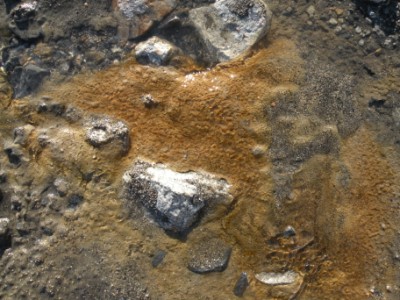
An algal mat near the Commonwealth Glacier
The stream team’s annual research efforts focus on measuring long-term changes in stream flow. The flow of the streams is strongly tied to climate, since sunlight and temperature are what causes melting of the glaciers. We can even see the changes in flow throughout the day as the sun circles the sky and moves across the faces of the 12 glaciers that surround the Fryxell Lake Basin where we are staying. Stream flow is measured at 16 gauging stations throughout Taylor Valley and several more in other nearby valleys. Each of these permanent stations is equipped with a big box full of equipment that continuously monitors streams throughout the Antarctic summer. Inside the box there are data loggers that measure water temperature, conductivity, and stream stage. Stream stage is essentially a measure of the depth of the water above a reference point. This is measured by forcing pressurized nitrogen gas from a tank inside the box, through a length of tubing, and out an orifice that is installed at a particular height in the water. The pressure in the tubing is a function of the height of the water above the orifice, so pressure in the tubing is recorded and converted into a measure of the stage of the stream. This is called a pressure transducer system, ingenious!
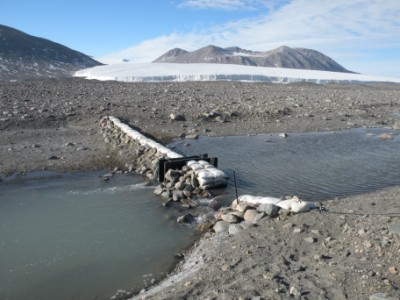
Stream guaging station along Aiken Creek
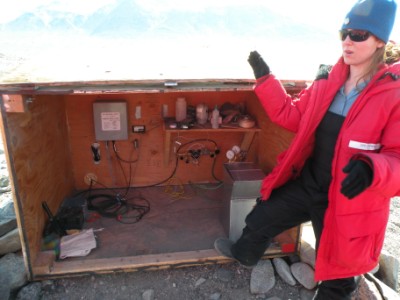
Lee showing us the stream monitoring equipment inside the gauging box
In addition to these continuous measurements of stream stage, the stream team visits each station once per week to check the gauges, collect water samples, and take a manual measurement of stream velocity and area. To measure stream velocity, a long measuring tape is stretched across the stream, and velocity is measured at regular intervals across the stream using a current meter, which consists of a propeller that is rotated by the action of the flowing water. With knowledge of the velocity of water and the width of the stream, the stream team can calculate a mathematical relationship between the stream stage and the discharge, which is the total amount of water that is flowing through the stream at any particular point. Stream discharge is what the stream team ultimately wants to know to help them understand the stream ecology, but as you can see sometimes in science we have to do multiple measurements and calculations to arrive at the variable we are most interested in!

Mike from the stream team measuring water velocity along the Onyx River in Wright Valley. He wears hip waders to stay dry while wading across the river, but it is still pretty cold in the 1.5º C water!
We have assisted the stream team with their measurements here in Taylor Valley over the last couple of days, and yesterday I was very lucky to get to join them on a trip to Wright Valley, the next valley over. There we measured stream flow on the Onyx River, the longest river on the whole continent! To get there, a helicopter picked us up at our field camp and we flew across the Asgard mountain range. The views from the helicopter were unreal.
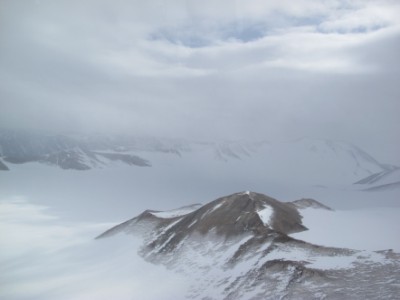
View from the helicopter on our way over the Asgard Range
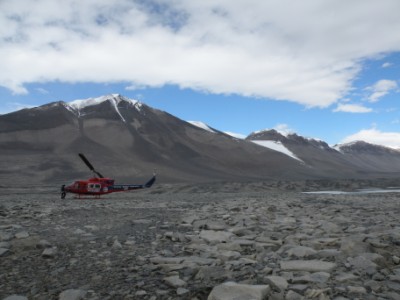
Our helicopter landing site in the Wright Valley.
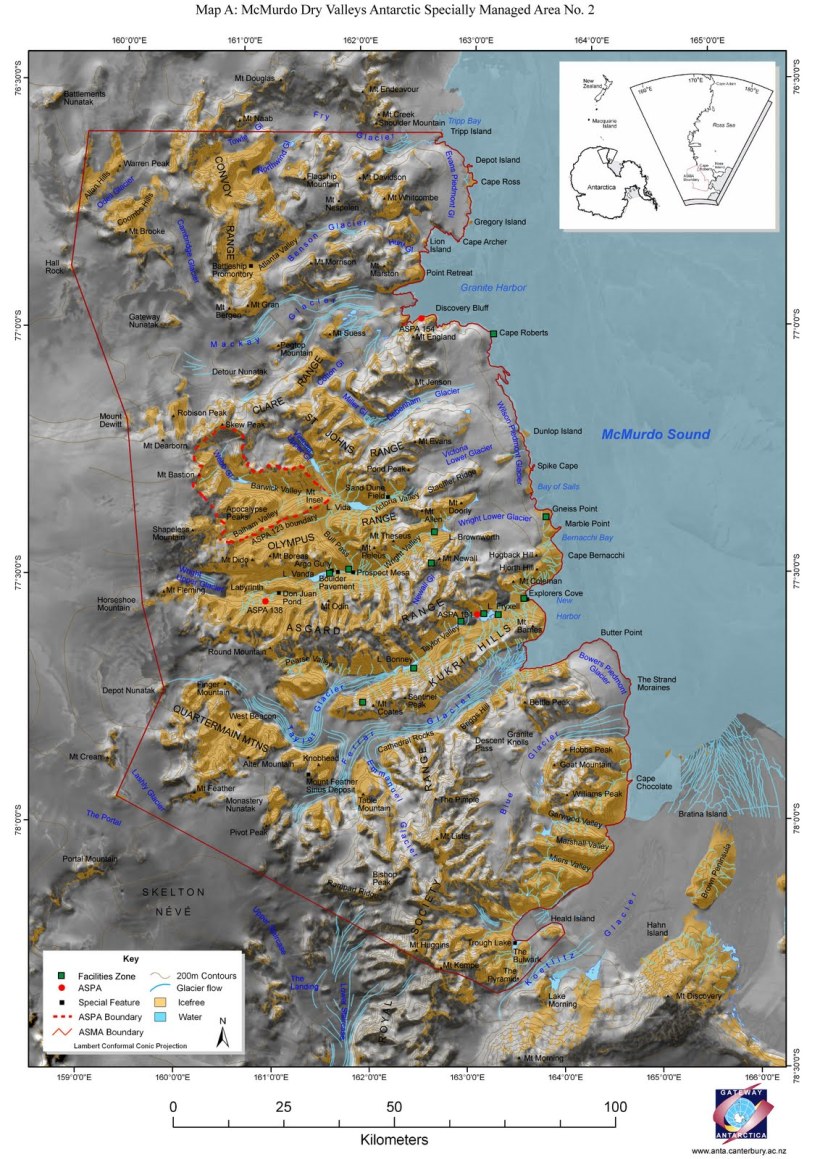
On the way home we couldn’t fly back the way we came, since the weather conditions had changed and the winds were too strong to make it over the tall peaks in the helicopter. Instead we flew out over the Lower Wright Glacier to the entrance of Wright Valley, past Marble Point, along the edge of McMurdo Sound, and back up Taylor Valley to Lake Fryxell. I was lucky to have the best seat in the helicopter (other than the pilot’s of course!) on the way home, and from the window I marveled at the landscape at the edge of the continent. Most impressive was where the Wright Lower Glacier pushed into the McMurdo Sound. Jagged pressure ridges form out of ice where the glacier meets the frozen sea and for me these images were an impressive reminder of the fact that these huge masses of ice are actually moving. Hard to fathom.
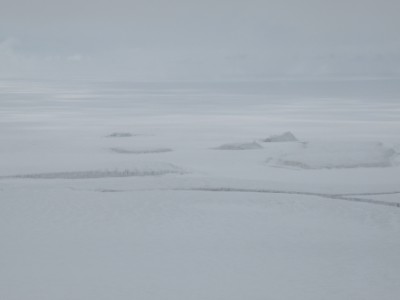
Pressure ridges where the Wright Lower Glacier meets the sea ice of McMurdo Sound
We are now back at F6, our field camp on Lake Fryxell. F6, by the way, is named after the stream gauging station that is located nearby. There are 10 gauging stations around Lake Fryxell, numbered F1-10. Streams that flow into other lakes are numbered with a different letter—B1-3 flow into Lake Bonney, H1-2 flow into Lake Hoare, etc. Interesting to think that the stream gauging station was here before the field camp!
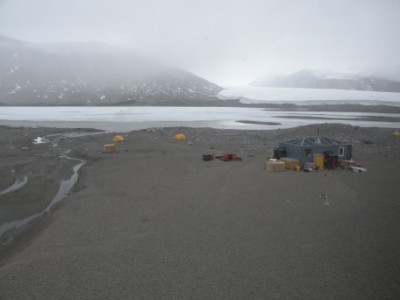
View of F6 from the helicopter as we returned from Wright Valley
Tomorrow we hopefully start with another project, looking at the effects of snowpack on soil chemistry and respiration. After all the training and logistical challenges we had to get through just to get out to the field, we are so excited to finally be working full speed on science!
More soon…

January 7, 2010 at 8:52 am
Hi Susan,
We are having so much fun keeping up with your journey! Enjoying your pictures and learning so much from your blog! Can’t wait to see you again and hear all about your experiences! Continue to enjoy, sending lots of love your way.
January 14, 2010 at 3:52 am
Randy and Sheri!! You guys rock!!
January 7, 2010 at 8:53 am
Great description of the area and stream research!
Have they introduced trout to the streams? jk
Bring back some pictures of the algal mats for my principles of ecology course. Thanks, and be careful.
January 7, 2010 at 5:50 pm
Seems like only a matter of time before trout are introduced, huh!? Hopefully that won’t happen here, or the seals will get to them before they are established!
January 7, 2010 at 8:54 am
Hi Susan, thanks for the detailed description of the field work you’ve been doing. The pictures are great! Have you all started on your reserch yet? Do you know your schedule as far as how much time you are at the field site versus time back at base?
January 7, 2010 at 6:02 pm
We have started our research, although we wont’ go collect samples until tomorrow. About 90% of a project is planning how to execute it! Kallin knows a lot about spatially explicit sampling, so we’ve designed a sampling design that will allow us to quantify variability in soils. We are measuring all of our sampling locations down to the nearest centimeter and laying everything out in advance, so we can take measurements as quickly as possible once we start. We will be measuring soil respiration, which changes based on temperature, so we need to get all of the measurements in a short time frame to minimize error.
Because the only way to get from McMurdo to the field is by helicopter, and helo time is in high demand, it’s easier to stay in the field the entire time we need to collect samples, and then return to base and finish our analyses there, rather than going back and forth. We have a couple days of lab work for each day of sampling, so we should head back to McMurdo on the 11th– this means we have only 3 more days in the field!
January 14, 2010 at 3:57 am
Hi Lesley! Thanks so much for all your comments. We are finally back at McMurdo from the field and we will be here for another week or so processing all of our samples. The research project has gone really well so far, we can’t wait to see our results!
January 7, 2010 at 6:55 pm
Is the stream team studying whether the streams are making the glaciers move faster, and are they studying those buried lakes that might be emptying? I love the blog and learning everything and keeping up with what you all are doing. And seeing Scott’s cabin must have been amazing!
January 8, 2010 at 7:36 pm
The Stream Team has an amazing long-term dataset that they can combine with the glacier folks and climatologists. Their main focus is on how climate variables correlate with stream flow (streams coming from the glaciers), but of course this can involve many factors. One of the main linfluences on stream flow– which has been really important the last couple years– is solar radiation, which melts the glaciers. As a consequence of increased solar radiation, we have had very high stream flows last year and this year (even though this year has not been as warm).
Scott’s cabin was fascinating! It was surprising to me to see remains of food (stored and in the pan!) still in the hut… seems like they must have left in a hurry. And the way things were like here back then, I can’t blame them! We are lucky to have heat, airplanes and wireless internet!
Loren
January 8, 2010 at 8:10 am
Wow, that’s not much time! Good luck with the sampling, and I hope it all goes well.
January 8, 2010 at 10:09 am
LET ME GET A SHOUTOUT TO MRS.WHITEHEAD!!!!
January 8, 2010 at 11:19 pm
Hi mrs whitehed we miss you we are moving on to a difffent since unit now .
January 14, 2010 at 4:28 am
Hi Brandi! Sorry I am missing the start of the new unit. I love mixtures and solutions!! We can work on some chemistry together when I get back. We have been doing lots of soil chemistry here in Antarctica, so I am kind of working on the same thing!
See you soon!
Susan
January 9, 2010 at 12:36 pm
Wonderful pictures!! I have spent an hour going through the blog which I finally found on Carey’s facebook page. What an incredible adventure you are having!!
January 14, 2010 at 4:30 am
Hi Mom!
Glad to hear from you on the blog!! We are indeed having an incredible adventure. Thanks for being an awesome mom and encouraging me to do things like this! Miss you!
Susan
January 10, 2010 at 10:14 pm
I hope everything is going okay there. I haven’t seen any updates since January 8.
I read in a newspaper about the Kaspersky Commonwealth Antarctic Expedition, 8 women from Commonwealth Countries (5 continents, 6 faiths, 7 languages) skiing 900 km to reach the South Pole. http://www.kasperskycommonwealthexpedition.com/about-the-expedition/index.cfm Unlike your scientific adventure, their trip seemed more political and celebratory (60 years of the Commonwealth). I bet everyone that you meet in Antarctica has a good story.
January 11, 2010 at 4:22 pm
Wow, I just reviewed your entire blog… so fun and fantastic to read about and see all of your adventures! Stay safe.
January 14, 2010 at 4:53 am
Hi Deb!! Thanks for taking the time to follow along. We feel so fortunate to have the opportunity to be here. It’s truly an amazing place. I thought of you and our pacific northwest adventures last night when we saw a pod of orcas swimming by…
Take care!
Susan
January 12, 2010 at 12:10 am
Susan-
so impressed with your adventure and what you got yourself into 🙂 who’da thunk on all those lovely Costa Rica nights that you would soon be stomping around Antarctica!? Glad you have the blog up – definitely interesting read and cool to know that I may never set foot there but at least I have a friend who has. Keep up the good work.
Todd
January 14, 2010 at 5:04 am
Todd!! Thanks for following along. Who’da thunk it indeed. It was a long bit of work getting here, but so so worth it. Hope to see you sometime soon–OTS 2008 reunion is long overdue!
Susan
January 12, 2010 at 3:38 pm
Excellent description of science in the field. You capture what makes the repetitive tasks of field research worthwhile. Please travel safely back to the station and keep us posted on how your analysis shapes up!
January 13, 2010 at 10:18 am
haha wow your picture are cool i hope you have fun…….
January 14, 2010 at 5:13 am
Hi Taylor! Thanks for writing!
January 13, 2010 at 10:24 am
hey hey hey I saw your sled can I go sledding
January 14, 2010 at 5:21 am
Hi Mason-
The sled was really just for moving our supplies around, we didn’t get to go down any hills. But that would be fun!! Maybe we’ll try to do that sometime soon if we have time.
See you soon!!
Susan
January 13, 2010 at 10:24 am
hi miss whitehead we really miss you i just have a question are glaciers just blocks of ice that happened to be there? how are they made?
January 14, 2010 at 5:40 am
Hi Marie-
What a great question!! We were just talking the other day about how we should write a post about glaciers because they are so cool! Glaciers are basically just huge blocks of ice that are moving over land. They form in areas where the snow and ice build up over time and eventually start to move downhill very, very slowly. Glaciers take a VERY long time to form, and some glaciers are still getting bigger, but a lot are getting smaller now since the earth is generally getting warmer. We’ll hopefully write more about glaciers soon, so keep checking back!
January 13, 2010 at 10:27 am
dear, Ms. Susan.
I love the article about the “stream team” and the pictures that go with it. I also like some of the articles about the bird and seals. another one i liked is about the dry vallys. that one also had great pictures. if you back to Birch Elementry, can you tell us how antarctica was? Bye!
From,
Wren.
(Birch Elementry School, Mrs. Freemann’s class)
January 14, 2010 at 5:45 am
Hi Wren-
So good to hear from you!! Thanks for your comment. I am so glad to hear that you liked the stream team article, we had a lot of fun working with such a great group of scientists. We will definitely be talking more about this when I get back. Look forward to seeing you and everyone at Birch!!
Susan
January 13, 2010 at 10:27 am
hi mrs. susan! all of the things your doing in antarctica sound really cool.i have been raeding all of your blogs and it sounds like your having a great time.have you seen any animals?(including nematodes)i cant wait to hear more of your trip when you come baack!HAPPY NEW YEAR!!!say safe!
January 14, 2010 at 5:48 am
Hi Katie-
I am so glad you have been reading all of our blogs!! Thanks so much for your comments. We have seen some wildlife here–seals, penguins, whales, and a couple of birds, but only out near the ocean, none of these things come up into the dry valleys where we were working. We will try to get some more pictures up soon!
January 18, 2010 at 9:09 am
Hi Susan!
I just caught up on your blog here and it’s awesome to read what you have been up to! It must be an amazing experience.
Take care and I wish you all the best!
January 20, 2010 at 3:34 am
Hey Ellen-
Good to hear from you! It has indeed been amazing. We feel very fortunate to have had the experience. Hope to see you soon so we can geek out about coreid bugs!
Susan
January 19, 2010 at 8:42 pm
It looks ridiculously stunning, this land you are visiting. Wow.
Great blog and I miss you being around the corner!
January 20, 2010 at 3:41 am
Hi Devon! Thanks for reading. It is stunning, for sure. See you soon!!
January 28, 2010 at 4:07 pm
Hey Mrs. susan i saw all your pictures of Antarctica. They all look very cool i hope you are coming back to Birch to tell and teach us about antarctica and more. The building is under construction so it gets pretty noisy around there now. Hope to see you soon -Drew